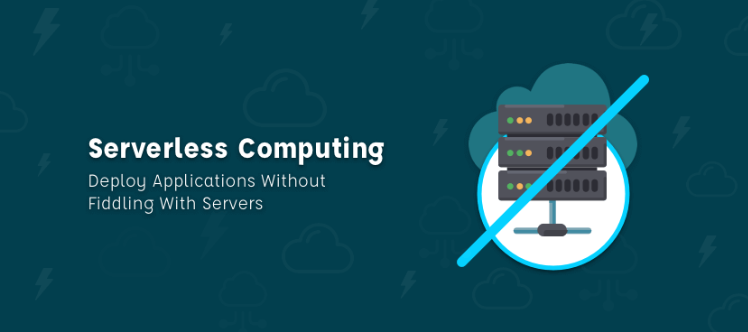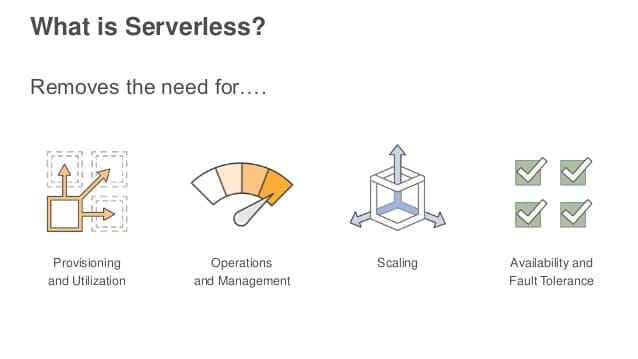Understanding Serverless for the Beginner
Understanding Serverless for the Beginner

A common misconception people have after listening to the word ‘serverless’ is that it does not consist of a server.
Well, that’s not the case at all.
Serverless means merely that you do not have to manage the server. Instead of running and maintaining your server, you can leverage the functions.
Wouldn’t it be great if you could devote all your time to building a better application without having to take care of the servers? That is when serverless can help you out.
This article will cover all the important topics you need to know, right from what is serverless to different frameworks, its benefits and why you should care.
Principles of Going Serverless
Serverless infrastructures include various principles which are stated as follows:

- Deploy third-party services: Various vendors act as third-party services.
- Creating a robust front-end: By executing functions at the front end through the client-side app framework, it helps reduce cost by decreasing function calls and execution.
- Carry out performance checks: Observing the performance of functions that slow down a particular service is essential to ensure good user experience.
- Single-purpose functions: As functions persist only for a limited amount of time, single-purpose codes are preferred for developing functions.
- Building security mechanisms: Security must be taken care of at the API and the FaaS layer. These security features include access controls, encryption, and authentication.
- Design a push-based architecture: This ensures that user input is not required for a set of events to take place.
Going Serverless
When you are building an application, you would want it to create a pleasant experience for its users.
For example, you want your application to provide an instant social media share feature, allow it to make in-app transactions and make uploading images and videos simpler and faster.
To make this all possible, the application requires a lot of back-end code that processes and runs the actions like in-app clicks, image uploading, moving from one page to another.

Managing the architecture to host and run this back-end code requires a lot of servers and dealing with various OS updates, not to forget the security.
Hence, we require some vendors to do the server managing for us, making us go serverless.
Before we move on to discuss these vendors, it is crucial for us to know the two leading cloud computing services involved in serverless cloud computing.
Function as a service (FaaS)
A popular and widely used platform. With the help of the FaaS platform, application developers can run and host their backend code within a serverless framework.
All the managing, scalability and security functions of servers will be taken care of by this serverless framework.
Different options are provided to carry out these functions by different vendors. Once the functions are completed and used on the FaaS framework, the services provided by a vendor for a function is then triggered through HTTP requests or from vendor-specific utilities.
FaaS is being used in real-time data processing these days.
Pros
- You pay for what you use
- Good management of infrastructure
- Secure and safe
- Easy and scalable implementation
Cons
- Limited memory and execution time
- Data is not stored
- Vendor lock-ins
- Debugging is not easy
Backend as a service (BaaS)
It is a cloud computing service that acts as a middleman that provides different ways in which a developer can connect their web and mobile apps to cloud services through APIs and SDKs.
There are only limited vendors for this platform and are comparatively newer than FaaS. It is similar to SaaS but is mainly for application development.
BaaS vendors provide a few components that can be plugged into the application.
With BaaS, we do not need to build any authentication functionality on our own. For example, logging in and signing up for an application requires authentication.
Pros
- Data storage control panel provision
- Pay for what you use
- Lesser development costs
- Fast and simple
Cons
- A code can be damaged easily
- Loss of data can take place
- Testing is difficult
- Not suitable for large-scale projects
Some other cloud computing terminology is:
- Platform as a service (PaaS): It provides a platform which lets a user manage, run and develop apps without having to build and maintain the architecture.
- Software as a service (SaaS): Vendors manage everything, the developers or users have to use these services.
- Infrastructure as a service (IaaS): Just an infrastructure base is provided. The developer has to work on the application by himself. Necessary infrastructure includes a virtual machine, software-network, and storage.
Let’s explore some of the Serverless platforms.
FaaS Platform
Many vendors provide compute runtimes which are known as function as a service (FaaS).
This platform executes application logic but does not store the data.
- Google Cloud Functions: Pay only for the time your code runs. It scales automatically.

- AWS Lambda: Amazon Web Services rectified many problems by launching its AWS Lambda technology. AWS Lambda is a service that runs your back-end code for you. It is supported by Node.js, Python, C#, Go and Java.
- OpenWhisk: IBM has also launched OpenWhisk which is an open-source serverless platform.
- Azure Functions: Azure is an event-driven serverless platform that supports JavaScript, C#, PHP, and Python.
BaaS Platform
- AWS DynamoDB: A NoSQL database for services that require consistent and single-digit millisecond latency.
- Amazon Cognito: Provided by Amazon Web Services is built to carry out user sign-up and sign-in to web and mobile applications.
- Firebase: Firebase was launched by Google. This platform is mainly used in mobile applications for development. It is a real-time database that stores and syncs data with the NoSQL cloud database.
Serverless Frameworks
Serverless frameworks are designed in such a way that building, testing and deploying serverless applications become very easy.
Let us take a look at a few prominent frameworks:
- Serverless: This framework is free, open-source and one which is written using Node.js.
- Kubeless: Concept used to develop a framework for Kubernetes.
- Fission: A serverless function framework for Kubernetes which supports Node.js, Go, C#, PHP.

- Up: an Open-source tool used to deploy HTTP servers.
- Nuclio: A framework that is open-source and runs up to 400,000 invocations per second.
Why should I use a serverless framework for my business?
Advantages of Going Serverless
- Deployment is easy: Fallbacks become simple because the versioning is made into the system itself.
- Seamless and transparent: You can match your business requirements with the different server capacities which are provided through this framework.
- No developers needed: Developers or administrators would not be required to run, update or add servers.
- Cost-effective: For platforms like FaaS, you do not have to pay for idle resources.
- Friendly: It gets along well with microservices.
- Makes you stay in the market: Going serverless decreases the time to get into the market and helps your software launch faster.
Drawbacks of Serverless
- Lack of tools: Developers are entirely dependent on a vendor for the debugging and monitoring of tools.
- Debugging is difficult: You need to get to the roots to find the source of the bug
- Complex architecture: It gets harder to manage too many functions.
- Testing: Integration and testing of serverless applications are complicated.
Future of Serverless
- Tooling: We can expect the tools deployed in serverless technology to increase and get better with time, making it convenient for developers.
- State Management: Certain drawbacks to serverlessFaaS are the way the platforms are implemented, but these can be fixed by new solutions or with the help of other companies.
- Increased transparency from vendors: There is going to be more transparency between you and the vendor about what you would expect from them as we rely on them for our hosting.
- Community: We can expect to see a huge growth of a serverless community
Conclusion
As we can see, serverless is an innovative and growing technology. An organization has benefitted from this technology since they do not have to spend a lot of managing their servers.
Also, it proves to be cost-effective and can be affordable for any business which wants to focus on building an application that wants to deliver an excellent experience for its users.
With the help of the FaaS platform, you only pay for the services needed. You can eliminate unwanted costs that are generated from idle resources.
We can expect many businesses and start-ups to deploy the serverless technology in the future.
Although it has some cons, it can be improved and used on a large scale. If you are very clear on your business goals and services, it is optimal to go with FaaS.
Of course, many would still prefer BaaS depending upon their requirements. Choosing the right vendor also plays a significant role.